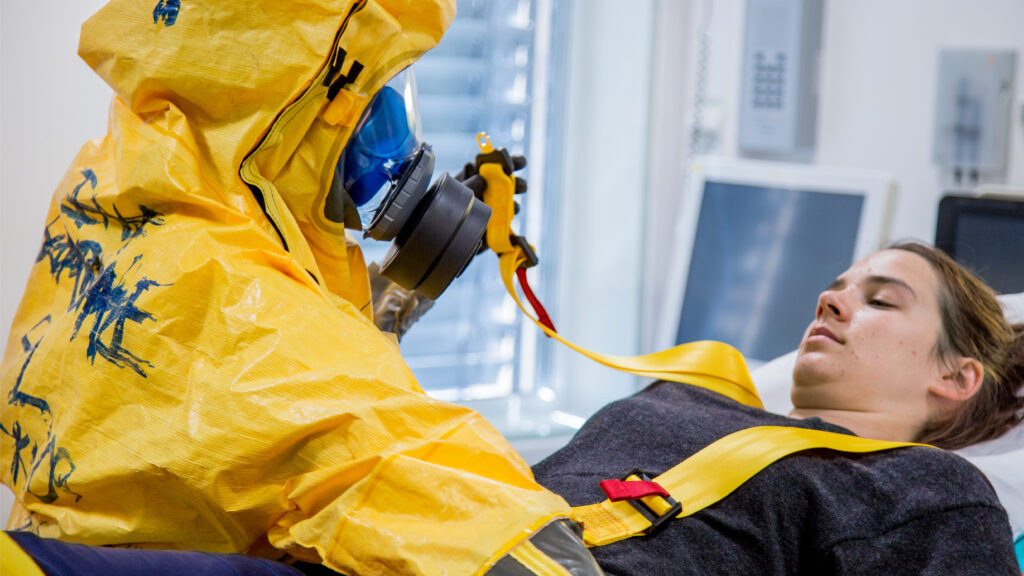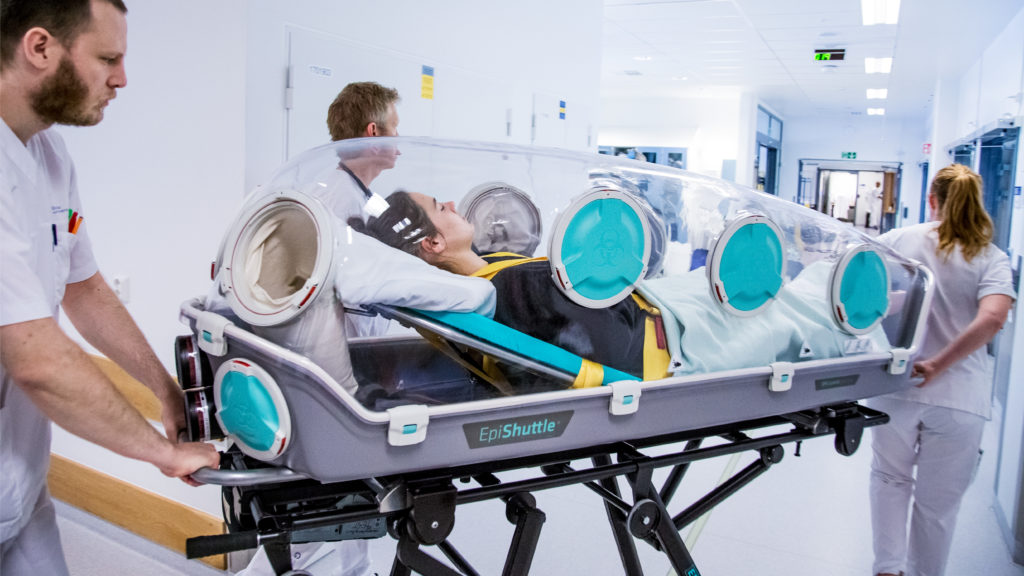Medical transportation of infected patients
In an era of increased globalisation and travel, infectious diseases can travel faster and longer than before – a prime example of this is the SARS-Cov-2 virus. The virus rapidly spread from China to the rest of the world and created the pandemic. Medical transportation and treatment of infected patients pose a set of risks, especially for healthcare professionals and ambulance services. They transport patients with serious illnesses or injuries daily – where they often encounter patients infected with dangerous pathogens. They expose themselves to the risk of transmission every day and without proper training, equipment, and procedures this risk increases.
What are the risks of transport of infected patients?
The risk of disease transmission increases during transport as there are many different occasions where it can happen. Whether it is in connection with PPE, the transfer from one team to another, or lack of training. To reduce the risk, these patients shouldn’t be moved or transported, unless it is highly necessary. They should only be moved and vacate the room for essential purposes, as well as have limited contact with other people.
Limiting contact with other people can be challenging as the infected patients have to be in contact with a number of health care professionals so they can provide care and treatment and run the necessary tests. In many cases, emergency services are likely to be the first in contact with the patient and offer care before being able to identify the pathogen. That can result in higher risk of transmission.
Safe infectious patient transport substantially minimises these risks, and it can be done safely and easily with the EpiShuttle.

How did the world deal with medical transportation during Covid-19?
Many institutions at the beginning were not prepared for any outbreak of highly infectious disease, in terms of routines, procedures, and equipment. This became clear as the SARS-CoV-2 virus spread, and hospitals didn’t have enough equipment or the correct routines for handling high demand.
The standard procedure of immediate isolation and transfer to high-level isolation, where they could provide supportive care and minimise the risk of secondary spread, were followed. However, with the high demand, this procedure only worked for a short time, as the number of available beds declined at a rapid pace, and the need to transport patients to other hospitals increased. Combination of all these factors have put a strain on the emergency services.
To keep up with the high demand, several countries provided aid and collaborated on transporting and treating patients. In France, they experienced a lack of beds, resulting in French patients being treated in Germany, Switzerland, Austria, and Luxembourg. Transporting these patients were done by converting high-speed TGV trains into mobile hospitals, as well as the military planes and continent’s ambulances aided with the transport. Germany’s air ambulance service helped further with transport using the EpiShuttle.
Risks associated with inter-hospital transport
Guidelines on inter-hospital transport are many. Ideally, for medical transport of infected patients, there ought to be dedicated teams, educated about infectious diseases, who take care of the patient during transport. However, emergency services are often the first people in contact with the patient and therefore they need to be sufficiently knowledgeable and trained. There are several steps to ensure that the patient is in contact with few people from the beginning, which already should start at the call center where they screen the patient.
As a standard, healthcare professionals should always wear appropriate PPE with every patient contact, as well as practice good hand hygiene. PPE should serve as the last line of defence against exposure when other procedures cannot avoid exposure. When preparing for the transport, the healthcare professionals must make sure that the driver compartment is isolated from the soon-to-be contaminated area, and it should always be considered as a clean area.
DFR Luftrettung recently ran 16 field tests to determine if pathogens can spread from the helicopter cabin to the cockpit, and “the tests indicated that with a spontaneously breathing patient there is a risk of pathogens not only spreading in the cabin, but also in the cockpit.” But with the help of a curtain between the cabin and the cockpit, the spread will minimise as it will capture the particles. In addition, the interior of the vehicle needs to be prepared to minimise exposure of surfaces and equipment.

There are other challenges associated with this type of transport other than transmission. This includes long shifts for health care professionals, multiple teams, costs, and availability. When a patient needs to be transported to another hospital, it requires a team of healthcare professionals who can provide care throughout the transport.
While in transit, healthcare professionals won’t have access to food or water, as they can not doff their PPE in the presence of the patient. Meaning they must endure long shifts in PPE, which can lead to fatigue and a higher risk of mistakes.
There is also a risk in handing over the patient to another medical team, as this is a gap in emergency preparedness and contingency plans. When a patient is delivered from one medical team to another, from one hospital’s contingency plan to another, it may be unclear who is responsible for safety and infection control around the patient.
Another challenge is the availability of qualified personnel and vehicles. As hospitals have a limited supply of vehicles for transport, this can be an issue when the hospital is under high pressure. After transporting an infectious patient an ambulance usually requires two to four hours for disinfection between each transport, while it can take up to a day to complete full disinfection of a medical helicopter – leaving the hospital with fewer vehicles.
Naturally, there is a cost associated with this, as the disinfection process, a number of medical teams and equipment required are not cost-effective.

What are the risks of transporting infected patients within the hospital?
There are many of the same risks to consider with intra-hospital transfer as when transporting from one hospital to another.
However, it also presents its own risks, as hospitals are the places where you will find the highest concentration of people at risk and where infections can have serious consequences. Infectious patients should only be moved when highly necessary, but it is often necessary to provide the right care and treatment.
There is a risk of transmission to other patients in the hospital, which can have lethal consequences. The hospital will have a wide range of patients, including immunodeficient patients. Depending on the hospital construction there might be a need to transport the infected patient near by the people at risk.
To reduce this risk or eliminate it, transport should be predetermined. Other patients, visitors, and the general public need to be cleared from the planned route at the time of the transport. If there is a need to use an elevator it needs to be secured so no one can use it until the patient arrives and it has been contaminated.
Healthcare professionals also need to be prepared for unexpected cleanups of spills and body waste. The hospital should also have an emergency evacuation plan in place, in case of weather, fire, or other catastrophes – the plan needs to avoid exposure to other patients or medical staff.
Can the transport of infected patients be safer?
The main objective is to minimize the transmission of pathogens and this can be done through preparedness and contingency plans. This includes careful surveillance for new pathogens, a scalable response system to respond to surge capacity, communication strategies, and the right equipment.
The EpiShuttle was created to protect the patient and the healthcare professionals during medical transportation. It is completely sealed and equipped with negative pressure, which means that the health care professionals don’t have to wear PPE during transport and it reduces the need for disinfection of the vehicles – saving valuable time and resources.
With the EpiShuttle hospitals can avoid disruption of vehicles from services, as it can be disinfected later, meaning the helicopters and ambulances can return to operation immediately.
In light of the pandemic, there is a larger focus on infection control and preparedness. It is easier to look at the mistakes and unpreparedness in hindsight, but there are also lessons to be learned. With the right procedures, equipment, and training we can minimise the risk of exposure during transport and treatment.
The standard procedure is effective, but it can easily fall apart due to human error and circumstances. The preparation of the transport requires multiple actions and precision, and with trained, vigilant staff it is safe. However, what happens when the pressure on healthcare professionals increases, the shifts get longer, and the right equipment is unavailable?
Have any questions?
DISCLAIMER: The medical device information is provided for general informational and educational purposes only and is not a substitute for professional advice. Accordingly, before taking any actions based upon such information, we encourage you to consult with the appropriate professionals. The use or reliance of any information contained on the site is solely at your own risk. The EpiShuttle does not protect against all types of CBRN occurrences. Accordingly please consult with medical professionals before usage.